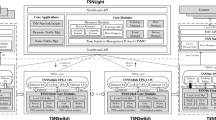Abstract.
In this paper, we present an adaptive buffering scheme for implementing intra-stream and inter-stream synchronization in real-time multimedia applications. The essence of the proposed scheme is to dynamically enforce equalized delays to incoming media streams, in order to piece-wise smooth the network delay variations and to synchronize the streams at the sink. An adaptive control mechanism based on an event-counting algorithm is employed to calibrate the PlayOut Clocks (POCs), which manages the presentations of multimedia data. The algorithm does not rely on globally synchronized clock and makes minimal assumption on underlying network delay distribution. Also, the user defined quality of service (QoS) specifications can be directly incorporated into the design parameters of the synchronization algorithm. The proposed synchronization scheme has been experimentally implemented in a teleconference system which consists of separately controllable audio, video, and data channels. The modular structure of the synchronization control provides the flexibility to maintain an arbitrary synchronization group in conjunction with a distributed conference management scheme. This paper also shows the experimental results of the test implementation and the suitability of the proposed scheme with respect to the multimedia traffic across an FDDI/Ethernet network.
Similar content being viewed by others
Author information
Authors and Affiliations
Rights and permissions
About this article
Cite this article
Xie, Y., Liu, C., Lee, M. et al. Adaptive multimedia synchronization in a teleconference system. Multimedia Systems 7, 326–337 (1999). https://doi.org/10.1007/s005300050134
Issue Date:
DOI: https://doi.org/10.1007/s005300050134




